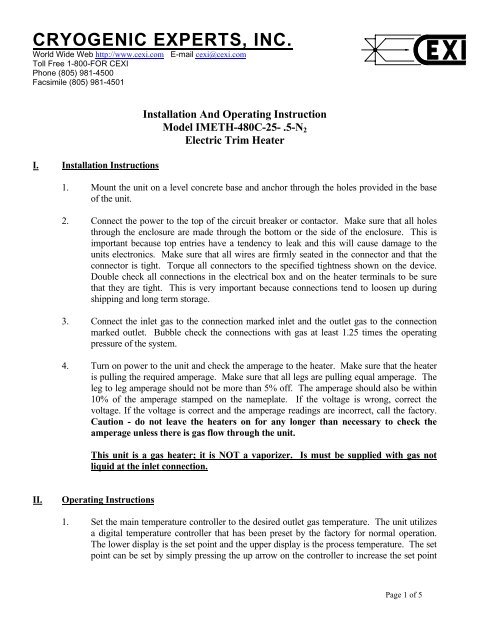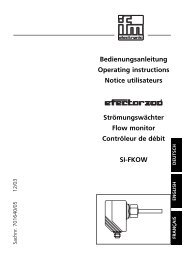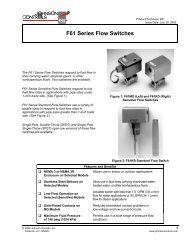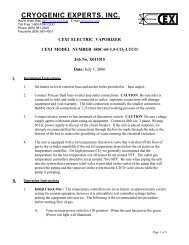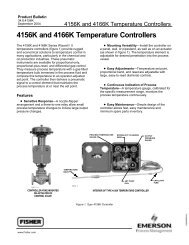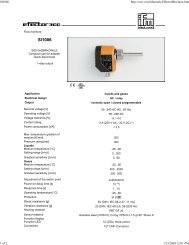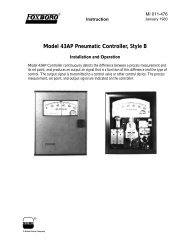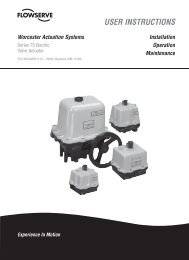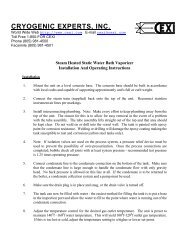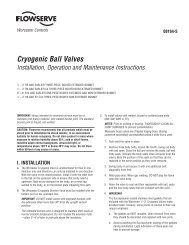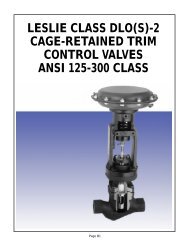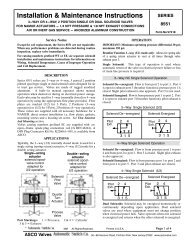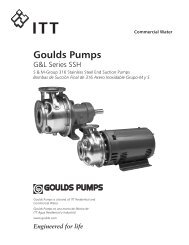Operating Instructions - Electric Gas Heater - Immersion Type ... - CEXI
Operating Instructions - Electric Gas Heater - Immersion Type ... - CEXI
Operating Instructions - Electric Gas Heater - Immersion Type ... - CEXI
Create successful ePaper yourself
Turn your PDF publications into a flip-book with our unique Google optimized e-Paper software.
and pressing the down arrow on the controller to decrease the setting. It takesapproximately 5 seconds for the change in the setting to take affect.2. Turn on the power to the unit. The green light should turn on at this time. If thetemperature is below the set point on the temperature controller, the amber light will turnon at this time as well.3. At this time the unit is ready to accept gas flow. As the gas flows through the unit, thetemperature will drop and the heater will turn back on. The heater will turn on and off asoften as is necessary to keep the outlet gas temperature at the set point. The normal cyclewill be on 15 seconds or so and off a short period of time. The ratio of off and on periodswill depend on the outlet gas temperature and the amount of gas flowing through the gasheater assembly. If the contactor is cycling quickly - every second or less, there is aproblem with the temperature controller. Shut the unit off immediately.4. Control ComponentsTemperature Controller - This is used to set the outlet gas temperature. The sensor - atype "T" thermocouple - is located in a well in the outlet header. This allows thethermocouple to control the gas heater temperature when there is no gas flow through theunit. Refer to the Athena 32C Manual included with the installation and operatinginstructions for further details on the Temperature Controller.Solid State Relays – These are power relays that control the power applied to the heaters.There are two of these relays that supply the power to the heaters – two leg three phasecontrol. The solid state relays are controlled by the Athena 32 C controller.<strong>Heater</strong> High Temperature Cut Off Switch - This is an over-temperature sensing devicethat monitors the heater sheath temperature. If the heater sheath temperature gets too hot,the controller will shut off the power to the contactor. This will turn off the heater. Thecontroller is set to 300 0 F.On Off Switch - This switch turns the control circuit power on and off.Control Circuit Fuse - This fuse protects the control circuit from overload. It is a 5 ampfuse.Thermocouple - This is a device that senses the outlet gas temperature or heater sheathtemperature. The outlet gas temperature thermocouple is located in the outlet header of theunit. The heater sheath thermocouple is located in a well in the heater flange assembly.Green Light - This is the power on light. It indicates that there is power to the unit.Amber Light - This is the heater on light. It indicates that power is being supplied to theSolid State Relays and that they are supplying power to the heaters.Control Circuit Transformer – This unit supplies 120 vac to the heater controls from themain 480 vac power feed to the unit.Page 2 of 5
III.SpecificationsModel IMETH 480C-25-.25-4 x 60<strong>Electric</strong> <strong>Immersion</strong> <strong>Heater</strong> For N 2 <strong>Gas</strong> Service (The heating element is directly immersedin the gas stream with this style unit). The unit can be ordered for 240 vac as well – pricingremains the same.Flow100,000 scfhMAWP250 psigFluid <strong>Gas</strong>eous N 2Inlet Temp 30°FOutlet Temp 70°F<strong>Operating</strong> Press60 psigPressure Drop1 to 2 psig at 60 psigFluid PassagesCarbon steelPower Required480 vac, 3 phase, 60 htz, 31 ampsKilowatts 25Inlet Conn.3” 150 lb. ANSI FlangeOutlet Conn.3” 150 lb. ANSI FlangeDimensions24” wide 60” tall x 70” long approx.Weight400 lbs. approx.The unit includes the following:1. NEMA 4 <strong>Electric</strong>al Enclosure2. Circuit breaker type disconnect3. Power contactor - used in conjunction with the high temp limit to shut off theheater if the casting over heats or the SSR’s fail.4. <strong>Heater</strong> sheath high temperature limit set at 400°F5. Solid state relays for applying power to the heaters (two leg control)6. Control circuit transformer7. Control circuit fuse8. Control circuit on off switch9. Power on light10. PID <strong>Type</strong> Digital Temperature Controller11. <strong>Immersion</strong> element assembly - low watt density heater12. Carbon steel shell assembly – powder coated13. Carbon steel stand assembly – powder coatedIV.Troubleshooting1. <strong>Gas</strong> Temperature Too Colda. Temperature controller set point too low1. Change the temperature setting on the main temperature controllerb. Power not turned on to the unit1. Turn on the power to the unitc. Contactor not pulling inPage 3 of 5
1. Check the out put from the temperature controller - make sure that120 vac is being supplied to the contactor2. Make sure that the High Temperature Cut Off Switch is not trippedd. <strong>Heater</strong>s not functioning properly1. Check the amperage on all the legs - be sure that all the legs areeven.2. Check the nuts that hold the wires to the buss bars and be sure thatthey are tight.3. Check all the buss bar bolts on top of the heaters and be sure thatthey are all tight.4. Check the continuity of the heaters and be sure that the heaters arenot shorted to ground and that they are not open.e. <strong>Gas</strong> flow too high and the unit is being overdrawn1. Reduce gas flow through the unit.f. Wrong power applied to the unit1. Correct the power to the unit.g. Thermocouple not properly positioned1. Check the thermocouple position on the main temperature controllerand be sure that the tip of the thermocouple is touching the end ofthe well.2. Be sure that the thermocouple is not shorted out or broken2. <strong>Gas</strong> Temperature too hota. Temperature controller set point too high1. Change the temperature setting on the main temperature controllerb. Contactor stuck1. Check the out put from the temperature controller - make sure thatthe output from the controller is cycling on and off.2. Turn off power immediately and replace the contactor.d. Thermocouple not properly positioned1. Check the thermocouple position on the temperature controller andbe sure that the tip of the thermocouple is touching the end of thewell.2. Be sure that the thermocouple is not shorted out or broken3. Generala. Power on and the unit is not responding to changes in flow.1. Make sure that temperature controller is set properly2. Make sure that the thermocouple is installed properly - near theoutlet connection.b. The contactor is cycling quickly - every second or less, there is aproblem with the temperature controller. Shut the unit offimmediately.1. The thermocouple is shorted or bad2. The temperature controller is bad.3. Allow the unit to cool and turn the power back on to the unit. See ifthe unit continues to cycle rapidly. If the unit continues to cyclerapidly the controller has a problem and should be replaced. If theunit does not cycle rapidly, there is probably a problem with thePage 4 of 5
high temperature cut off switch mounted on the heater sheath or inthe shell header. This can be checked by jumping the hightemperature cut off switch out and observing if the rapid cyclingstops. Do not leave the unit jumped out or catastrophic failure mayoccur.V. Set Up Parameters - Watlow 965 ControllerLOC 0InputTRSPOffC-FFRL -50RH 150OT1HtOT2HtSp2 73PB-1 15RE1 0.00RA1 0.00CT1 15CAL 0Aut 0Page 5 of 5


